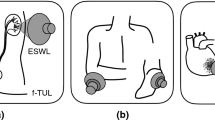Abstract
Two main mechanisms govern the field of laser lithotripsy. The first mechanism produces mechanical stress inside the stone by absorbing the laser light at the stone surface. Therefore it depends on the stone's optical properties. The second method uses a Q-switched laser and an energy converter to release mechanical shock waves acting on the stone to cause its fragmentation. This method is called laser-induced shock wave lithotripsy (LISL). The converter must be attached to the light transmitting optical fibre and should not provide an increase of the overall diameter of the probe to fit in a small, flexible endoscope. So we used the irrigation liquid, which must be supplied for endoscopic lithotripsy. Adding of Fe3+-ions to the isotonic saline solution (0.02 mmol l−1) lowered the intensity threshold for the energy conversion. With this special irrigation liquid we have a continuously regenerating energy converter. It allows the use of bare fibres with spherically shaped tips, which can be easily changed while the endoscope remains inside the patient's body.
Similar content being viewed by others
References
Watson GM. A survey of the action of lasers on stones. In: Steiner R (ed)Laser Lithotripsy New York: Springer, 1988
Fair HD. In vitro destruction of urinary calculi by laser-induced stress waves.Med Instr 1978,12:100–5
Wondrazek F, Frank F. Devices for intracorporeal laser-induced shock wave lithotripsy. In: Steiner R (ed)Laser Lithotripsy, New York: Springer, 1988
Schmidt-Kloiber H, Reichel E, Schöffmann H. Laser induced shock wave lithotripsy (LISL).Biom Tech 1985,30:173–81
Schmidt-Kloiber H, Paltauf G, Reichel E. Investigation of the probabilistic behavior of laser-induced breakdown in pure water and in aqueous solutions of different concentrations.J Appl Phys 1989,66:4149–53
Calculas SL2. Data Sheet: Fa. Karl Storz GesmbH & Co. Tuttlingen BRD, 1989
Author information
Authors and Affiliations
Rights and permissions
About this article
Cite this article
Reichel, E., Schmidt-Kloiber, H. Laser-induced shock wave lithotripsy with a regenerative energy converter. Laser Med Sci 7, 423–425 (1992). https://doi.org/10.1007/BF02594083
Received:
Issue Date:
DOI: https://doi.org/10.1007/BF02594083




